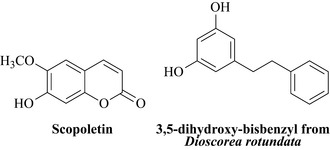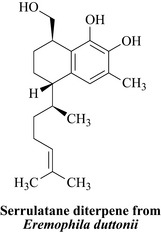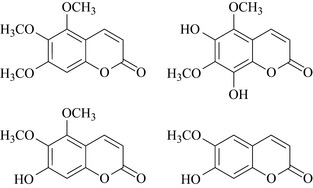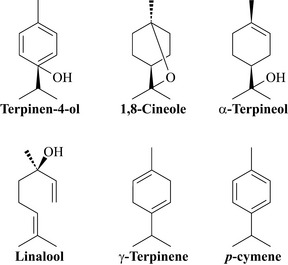Chapter 18 Infectious diseases
There are many reasons why plants are a valuable source of antimicrobial natural products and the most fundamental reason is that they contain intrinsically antimicrobial compounds such as carvacrol (Fig. 18.1 and see Chapters 6 and 7) from Thyme (Thymus vulgaris, Lamiaceae) which is a monoterpene and is present in the essential oil of this species.
This phenolic monoterpene has a range of antibacterial and antifungal properties (Baser 2008) and may be produced by the plant to protect itself from attack from plant pathogenic microbes and insects that are present in its environment. This is an example of an intrinsic or latent antimicrobial natural product that the plant produces as a normal part of its chemistry which can be used medicinally. Plants also have the ability to produce antimicrobial natural products when they are under attack from microbes, herbivores and insects. These compounds are very quickly synthesized by the plant and are called phytoalexins which display antimicrobial properties to a wide range of bacteria and fungi. Examples of this phenomenon include the potato, which when inoculated with a fungus synthesizes the antimicrobial coumarin scopoletin (Fig. 18.2 and Chapter 6) and the bisbenzyl compound (3,5-dihydroxy-bisbenzyl) also depicted in Fig. 18.2, which is produced by a species of yam (Dioscorea rotundata, Dioscoreaceae).
This bisbenzyl is very strongly active against a range of Gram-positive and Gram-negative bacteria including Staphylococcus aureus, Bacillus cereus, Pseudomonas aeruginosa and Escherichia coli with minimum inhibitory concentrations of 10 mg/L (Fagboun et al 1987). This is astounding activity, particularly against Gram-negative bacteria such as E. coli and P. aeruginosa which are often impervious to plant antimicrobials.
Plants are also used extensively as topical antimicrobials in many societies and there is an enormous body of primary literature in journals that specialize in ethnomedical research such as the Journal of Ethnopharmacology. In the North-Eastern part of Australia the indigenous peoples use the aerial parts of Eremophila duttonii (Myoporaceae) as a topical antibacterial preparation (Smith et al 2007) and the active constituent has been isolated and characterized as an unusual serrulatane diterpene (Fig. 18.3).
Probably the most important reasons that plants produce antibacterial natural products, and why they could be a valuable resource of antimicrobial materials, is that these chemicals are often exceptionally diverse, have stereochemical centres and have extensive functional group chemistry. These factors mean that the compounds will have very distinct shapes, developed by nature over millions of years to bind to protein and DNA targets, and consequently having an inherent biological activity. The readers are urged to consult a new and very important review on natural products highlighting this topic written by Professor Giovanni Appendino and colleagues (Appendino et al 2010). Plant antibacterials are very different in shape and chemistry to existing antibacterial chemotypes (Gibbons 2004, 2008), that are often microbially derived such as erythromycin (Fig. 6.11, Chapter 6) and tetracycline (Fig. 6.8, Chapter 6). This may mean that plant-derived antibacterials could function through a different and as yet undetermined mechanism of action. This would make them valuable where bacterial resistance to conventional antibiotics (beta-lactams, macrolides, tetracyclines) has arisen as these bacteria may be susceptible to these agents by working in a very different way. New agents that function by a different mechanism are currently needed, particularly in bacterial infections such as tuberculosis where the causative organism, Mycobacterium tuberculosis may possess multiple resistance to existing antibiotics of choice.
Broad-spectrum antimicrobial agents
Umckaloabo (pelargonium), pelargonium sidoides DC and P. reniforme curt (pelargonii radix)
Therapeutic uses and available evidence
Extracts of Pelargonium species have been shown to inhibit the adherence of bacteria to cells of the mucous membrane and there is some published chemistry and biology on methoxylated coumarins (Fig. 18.4) from P. sidoides which have weak antibacterial activity (Kayser and Kolodziej 1997). They have also been shown to interfere with viral replication (Michaelis et al 2011) and to inhibit viral adherence to cells of mucous membrane and to loosen viscous mucus in the respiratory tract. It has also been postulated that these extracts have immuno-modulatory properties. There have been some small clinical trials on efficacy in reducing the symptoms associated with tonsillitis and bronchitis, particularly amongst children (Matthys et al 2007). These materials are not, however, a replacement for antibiotics, but they may be used as a supplement to ameliorate the symptoms associated with inflammation of the upper respiratory tract (URT).
There has also been a study on extracts demonstrating weak antibacterial activity which is due to the presence of the ubiquitous unsaturated fatty acids oleic and linoleic acid against fast-growing species of Mycobacterium; however these compounds are unlikely to be responsible for the ‘anti-TB’ activity of Steven’s cure (Seidel and Taylor 2004).
Lemon balm, melissa officinalis L. (melissae folium) 
There are a number of topical formulations which are marketed for Herpes simplex virus skin lesions and there are clinical data and some in vitro activity has been confirmed with the extracts of Melissa officinalis (Koytchev et al 1999). The herb is generally well-tolerated, although it has been suggested that long-term use may interfere with thyroid function.
Therapeutic uses and available evidence
Lemon balm is antimicrobial, carminative and sedative. Hot water extracts have antiviral properties, mainly due to the polyphenolic acids. Topical formulations are used for Herpes simplex virus skin lesions, the antiviral activity having been confirmed in vitro and also by clinical trial. Aqueous extracts also inhibit division of tumour cells, and tannin-free extracts inhibit protein biosynthesis (for review, see Ulbricht et al 2005). The herb is used as an ingredient of herbal teas, often with other herbs, for nervous disorders and insomnia (see Chapter 17). Lemon balm is well tolerated, although it should not be taken internally in high doses over a long period because of its reputed antithyroid activity.
Garlic, Allium sativum L. (Allii sativi bulbus) 
Garlic, and other Allium spp. (Alliaceae), have a very long history as both a topical and systemic material to treat various infections. The literature is full of in vitro studies showing efficacy of the extracts and oils of the bulbs of various Allium species with activity against various bacteria, fungi and viruses. The family has a long and rich usage as culinary herbs with onions, garlic, shallots and chives all producing antimicrobial sulphur containing natural products, typified by allicin and ajoene (Fig. 18.5). Garlic has been used clinically for the treatment of tuberculosis with some success in the United States in the 1940s and it has been referred to as Russian penicillin, as a result of its wide use in the former Soviet Union, again with some considerable success as an antibacterial (Bolton et al 1982). The widespread use of garlic has prompted recent investigation of other species which may harbour useful natural products and a number of interesting sulphur-containing antibacterials with very potent antibacterial activity have been isolated, such as the unusual pyridine-N-oxide natural products from Allium stipitatum (Fig. 18.6, O’Donnell et al 2009). These compounds displayed activity against slow- and fast-growing mycobacteria and a range of Staphylococcus aureus species some of which were methicillin-resistant and multidrug-resistant.
Therapeutic uses and available evidence
Garlic extracts have been shown to have antibiotic, expectorant and anti-thrombotic properties and many garlic preparations are marketed for their anti-blood clotting properties and to give some protection against atherosclerosis. Preparations from common garlic have also found much use in the treatment for respiratory tract infections, such as common cold, flu and bronchitis. The allyl sulphides, such as allicin and ajoene, are strongly antimicrobial having activity against Staphylococcus aureus, Streptococcus species and even some Gram-negative bacteria, such as Helicobacter pylori, the major bacterial causative agent of stomach ulcers (Harris et al 2001).










